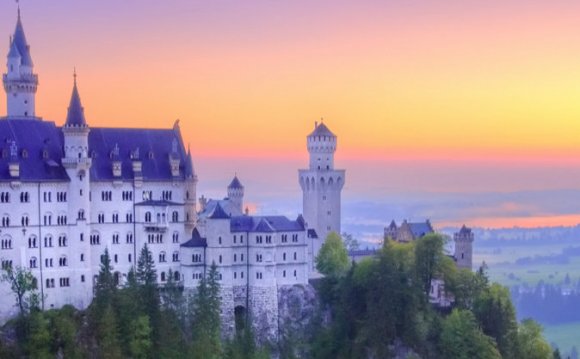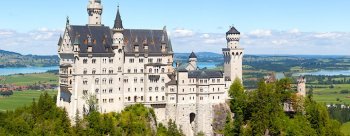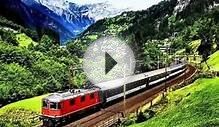
 Germany is synonymous with a lot of things – beer, food, sausages, seriousness, hiking, castles, and parties. Yet Germany is more than beer halls and bratwurst. There is a vibrant art and music scene in Berlin, beautiful forests in the west, great cathedrals and castles, and picturesque “sound of music” cities and the alps in the south, and historic cities throughout the country. Germans are often thought of as serious people who aren’t as wild as their southern European neighbors. Yet, while they may be serious and focused, they are also some of the nicest, most helpful people in Europe. They aren’t as “cold” as they appear. Germany is a large country with a lot to offer travelers at really affordable prices.
Germany is synonymous with a lot of things – beer, food, sausages, seriousness, hiking, castles, and parties. Yet Germany is more than beer halls and bratwurst. There is a vibrant art and music scene in Berlin, beautiful forests in the west, great cathedrals and castles, and picturesque “sound of music” cities and the alps in the south, and historic cities throughout the country. Germans are often thought of as serious people who aren’t as wild as their southern European neighbors. Yet, while they may be serious and focused, they are also some of the nicest, most helpful people in Europe. They aren’t as “cold” as they appear. Germany is a large country with a lot to offer travelers at really affordable prices.
Typical Costs
Accommodation – Accommodation in Germany is quite cheap compared to neighboring Euro-zone countries. Hostels range from 10-30 EUR per night for a dorm room. A private room costs around 50 EUR per night and budget hotel prices begin in the same price range.
Food – Food in Germany is very cheap. You can eat out from outdoor vendors for around 2-4 EUR (great sausages and bratwurst). Pre-made sandwiches cost around 5 EUR. Fast food will cost around 7 EUR. Beer usually costs 5 EUR for a nice pint. If you eat in the beer halls, a traditional German meal plus a beer will cost around 14 EUR. Turkish, middle eastern, and Asian food can be found for as little as 5 EUR. A week’s worth of groceries will cost around 35-65 EUR.
Transportation – High speed trains are very expensive in Germany. Berlin to Munich can cost over 180 EUR. Most of the other intercity trains cost between 40-70 EUR for a second class ticket. It’s cheaper to take a slow regional train or overnight bus, and then you save on accommodation. City transit systems cost around 1-3 EUR per single ticket.
Activities – Museums cost between 1-15 EUR. Bike tours and river cruises can cost 24-40 EUR. Most city tours are between 12-25 EUR. Renting a bike costs about 18 EUR per day.
Money Saving Tips
Eat at the vendors – Throughout Germany you’ll find cheap outdoor sausage vendors. These quick eats will cost a couple of Euros. Moreover, meals at many of the beer halls around the country cost only 9-15 EUR.
Eat cheap ethnic food – Some of the best and cheapest food in Germany is the Turkish and Middle Eastern food. You can get a lot of meals for under 5 EUR. It’s delicious, filling, and cheap and what I mainly eat while in Germany.
Take the free tours – The bigger cities in Germany have free sightseeing tours. They are a good way to see the city, learn about the history, and get your bearings without spending money.
Drink cheap beer – German beer is very strong and very cheap. Drink the local beer, and you’ll save yourself a lot of money. After all, Germany is known for beer drinking.
Book your train early – Trains in Germany are expensive but you can get a saver ticket that is around 40-50% off the standard fare if you book at least a week in advance. These tickets have limited availability though so be flexible with your travel plans.
Rideshare – If you’re flexible in your schedule, use the ridesharing service Mitfahrgelegenheit.de and catch rides with locals between cities (or countries). You save money and get to spend time with locals. Drivers are verified and it’s perfectly safe (though sometimes rides don’t show up, which is why you need to be flexible).
Top Things to See and Do in Germany
Germany’s hip capital has world-class museums, history, funky neighborhoods, and one of the best nightlife’s in Europe. I didn’t like this city at first but after visiting a second time, I saw the amazing city everyone told me about. From the museums to the art and music scene to the great bars and cheap food, Berlin is is amazing, and one of the cheapest European capitals. Read More: How to make the most of your time in Berlin.
Berlin’s quiet, upscale cousin – Munich – is a city steeped in history with small streets, great beer halls, amazing food, a beautiful park, surfers, and a royal palace. It’s one of Germany’s more expensive cities but it’s a beautiful destination and there are a lot of nearby Bavarian towns that make for good day trips.
Hang out at Oktoberfest – The world’s largest two-week beer festival filled with huge steins and giant pretzels. I went there for 5 days and had the time of my life. Buy some lederhosen, raise a glass, and sing some German beer songs. ‘Nuff said. Read More: How to survive Oktoberfest.
Hike the Black Forest – Located near the French border, the Black Forest is named so because of the dark green pine trees in the area. There are hundreds of miles of hiking trails worth exploring. You can spend some time stopping in towns that are famous for their cuckoo clocks and typical German food. It’s a beautiful area best seen in the fall.
Fall in love on the Romantic Road – A string of historic cities in Bavaria, the Romantic Road is a great route that helps you explore majestic Bavarian towns surrounded by snow capped mountains. It can get quite touristy but it’s a beautiful and relaxing area to go with a significant other or family.
Explore Lake Constance – Lying along the country’s southwestern border with Switzerland and Austria, Lake Constance is Germany’s largest freshwater lake. The area around the lake and up the lower Rhine valley has a very mild, amiable climate and fertile grounds, making it the country’s most important area for wine and fruit production.
Hike Berchtesgaden National Park – This national park is an alpine heaven of lush forests, steep rock faces, crystal clear lakes, sleepy villages, and rolling meadows. It’s just you, the chirping of birds, and cows ringing their brass bells. Well-marked trails wind through the spectacular scenery, which brims with opportunities for hiking, and cycling.
Check out Trier – This is the oldest German town in the country. With a 2000-year-old history, Trier was home to six Roman emperors and contains a number of impressive ancient ruins. The most outstanding example is by far the Black Gate – a monumental structure that was once part of the city walls. Nested in the Moselle river valley, picturesque Trier is crowned with myriad vineyards and pastoral villages. It is very much an off-the-beaten-path destination.
Visit Dresden – Explore the treasures and grand buildings of this baroque beauty, which is bisected by the majestic Elbe River. This city was completely rebuilt after the war and today is one of the biggest nightlife spots for young people.
Spend a day in Cologne – A historic city with a great cathedral. Cologne is a great place to stop in west Germany on your way to or from the Netherlands. The cathedral itself is worth the visit. It’s huge!
Stand in awe of Neuschwanstein Castle – This is a 19th-century neo-romantic palace perched on a rugged hill near Füssen. The palace was commissioned by “crazy” Ludwig II of Bavaria as a retreat and as an homage to Richard Wagner. It’s the model for the Disney castle, and definitely on a Germany bucket list.
– Another great city of Germany, Frankfurt is home to several different restaurants, historical sights, and mentally-stimulating attractions. There is a great exhibition hall—one of the largest in the world—and several science museums to check out. It’s less expensive compared to other cities in Germany, and a great airport hub to fly in and out of.
RELATED VIDEO












